"Goldilocks was hungry. She tasted the porridge from the first bowl.
'This porridge is too hot!' she exclaimed.
So, she tasted the porridge from the second bowl.
'This porridge is too cold,' she said.
So, she tasted the last bowl of porridge.
'Ahhh, this porridge is just right,' she said happily and she ate it all up." -Goldilocks and the Three Bears
Life as we know it on Earth all makes great use of one particular molecule in one particular phase:
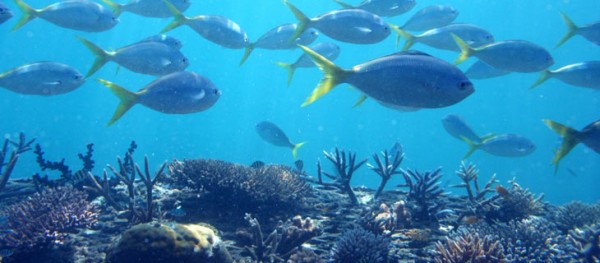
Liquid water! Having a liquid phase to water requires an atmosphere with enough pressure (and something with even 1% of Earth's atmosphere will do it), but it also requires the right temperature to be a liquid.
And this is important! Water in its solid phase doesn't really lend itself -- in our experience -- to the flourishing of successful lifeforms.

And it's the same deal at the other extreme: water vapor -- water in gaseous form -- doesn't have the same properties as liquid water. And we don't know of any lifeforms that make use of water vapor for vital biological processes the way they do with liquid water.
And that's what happens if the temperature gets too hot: liquid water boils and goes into a gaseous phase.

(Although it makes life taste delicious, it doesn't, in our experience, make life from scratch.)
And as far as we know -- which isn't all that far -- the Earth is the only planet with liquid water on its surface, and the only planet with life on it.
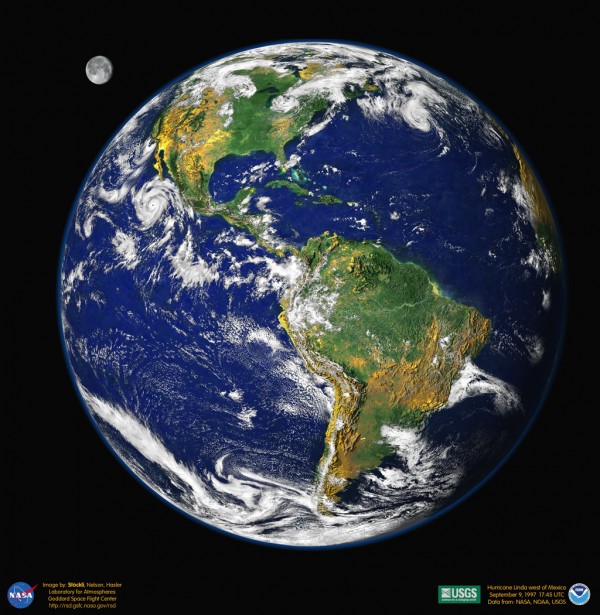
Earth has the right temperature range for its pressure -- between 0 and 100 degrees Celsius at 1 atmosphere -- for liquid water to exist in vast quantities. What's more, is that Earth has had these conditions for the entire 4.5 billion year lifetime of our Solar System!
Sure, there are some other worlds that may have had liquid water once.
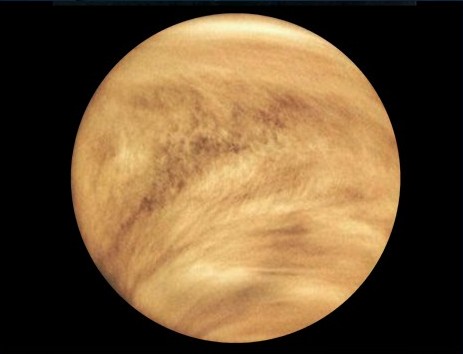
Venus, for example, is estimated to have had the right conditions for liquid water for about the first 300 million years of the Solar System. But the atmosphere got too thick, and the once-Earthlike temperatures skyrocketed. Thanks to the extreme greenhouse effect it experiences, the average temperature on Venus is now about 500 degrees Celsius, which is far too hot for liquid water.
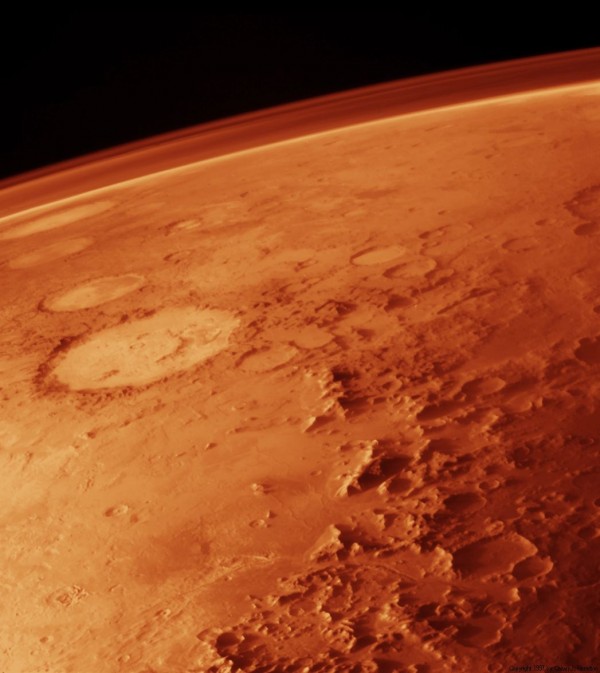
And the opposite is true for Mars! Despite being so much farther away from the Sun, Mars is still close enough that, if it had an Earth-like atmosphere, it probably had liquid water on its surface for more than a billion years! (Dried up riverbeds seem to support this.)
But with most of its atmosphere lost due to the solar wind, Mars is now a frozen wasteland, with no liquid water on the surface.
But, as you know, we are not limited to the Solar System, and each shining light in the night sky holds the promise of a possibly habitable world!
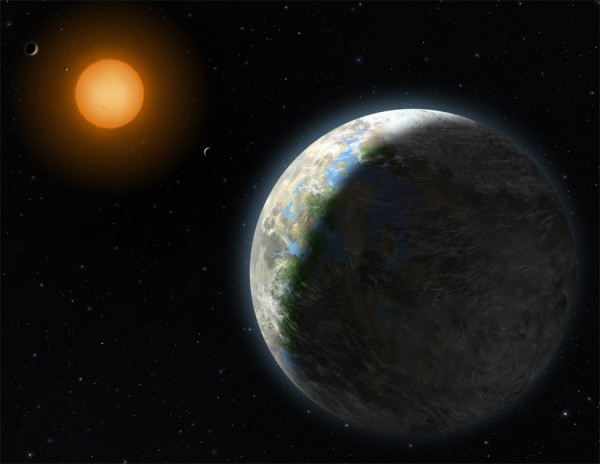
Well, one of these stars in the night sky, Gliese 581 (which I've written about here and here) is now known to have six planets orbiting it, the latest of which is the most interesting!
Why's that?
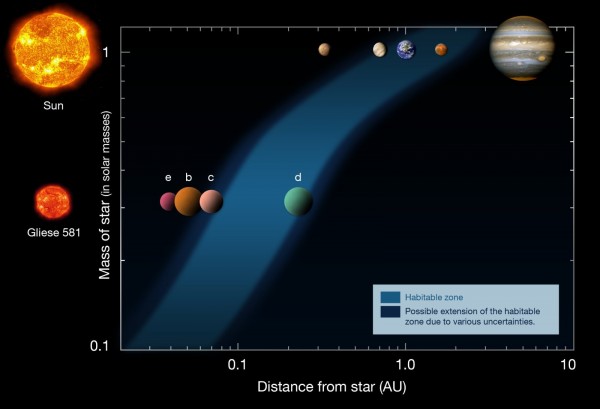
Because every star has what we call a habitable zone (or Goldilocks zone) around it, where the temperature is just right for a planet with an Earth-like atmosphere to have liquid water!
Can you guess why we're excited about this latest, sixth planet orbiting Gliese 581?
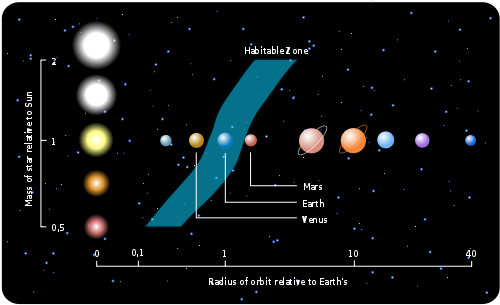
Because, not only it is a rocky planet like Earth, but because it's smack in the middle of its habitable zone!
Now this doesn't mean that this planet has life on it, or even liquid water, but it does make it the best known candidate outside of our Solar System.
More importantly, it's the first great candidate, and it's only 20 light years away! (The closest star outside of our Solar System is already over 4 light years away, so this really isn't that far!)
We think that probably about 10-20% of all stars have planets in their habitable zones, but this is the first time this scientific idea has been verified outside of our own Solar System! What's the next step? The next step, of course, is to build a good enough telescope with a spectrometer (or a differential brightness mechanism to look for clouds) to look for signatures of liquid water on this world; but I think this step is totally one worth celebrating! Pretty soon, it'll be time to call the new alien ambassador...

"[Mars] probably had liquid water on its surface for more than a billion years! (Dried up riverbeds seem to support this)"
I've never understood this argument. I appreciate that dried up riverbeds is evidence for liquid.
And, on earth, the most likely liquid would be water.
But why would we assume that evidence of liquid on another planet is evidence for water?
There are thousands of liquids. Why not ammonia (to pick a random example)?
It is liquid below -33°C. The average temperature on Mars is -63°C.
The planet has more Nitrogen than Oxygen - so intuitively NH3 seems more likely than H2O - and the temperature range is right.
Yeah - I'm not a chemist. My example is arbitrary.
It just seems very earth-prejudiced of us to keep seeing thinking that evidence of liquid is evidence of water.
Mac
What bothers me is that if we found a patch of scrawny weeds and a puddle full of pond scum and amoebas on another planet we'd be ecstatic. Yet we have no proper feeling of awe when confronted with all the amazing forms of life that we as humans are slowly causing to go extinct right here on our home planet. How sad!
'Scuze me, but it's plainly obvious that if there were another planet with life it would have been in the Bible.
Game, set, match!
(We all know this argument is coming, so I'm implementing my Doctrine of Preemptive Mockery.)
So how long until we're able to chemically analyze its atmosphere?
This notion of a "habitable zone" is far too restrictive. Jupiters' moon, Europa, appears to have a moon-wide liquid water ocean under a thick layer of ice. It is quite possible, if this is indeed the case, that life exists in this ocean. Europa is not in a "habitable zone" by any stretch of the imagination.
regarding Venus: the right conditions for liquid water for about the first 300 million years
Which was more than enough time for interesting thing to happen in the way of life. There are probably the remains of cities of great venusian civilizations hidden under the clouds!
Mac, my understanding of the situation on Mars is:
1) There are mineral traces that typically form in water.
2) The current atmosphere on Mars is what's left from 4 billion years of loss to space. This loss isn't the same across all molecules, which means that the atmosphere we see now has a different composition than what there would have been for it's first billion years. I believe Scientific American had a nice article on this topic earlier this year.
And Fred -- right on!
Mac -- there's no liquid in the universe that's quite like liquid water. There's all kinds of telltale evidence. We know that the Martian riverbeds were made by water by the sorts of sediments that are present there.
This is really cool, where did the habitable zone graphics come from?
Aahhh, I clicked through to wiki and found them.
Dr. S,
You never mentioned what the atmospheric pressure is estimated to be on this 6th planet. Sure its rocky and in the Goldilocks zone, but does it have sufficient atmospheric pressure to hold the water to the surface in liquid form?
Lets say we do build a spectrometer and look at the light from the 6th planet. Now we all know planets/moons do not give off light of their own. So when I take a spectrograph of lets say our moon, won't the information contained in that light bouncing off the moon only give me data on our sun? Or will it give us information on just the moon? Or does it give us an overlay of both the sun and moon's composition on one graph? Basic logic suggests to me that we will get information from the moon itself b/c the light will be absorbed and re-emitted in different wavelengths by different elements, so I guess my question is will the moon composition information be added to the original light sources (sunlight) composition information when we look at the graph? I don't see how the information contained within the light leaving the sun would get lost after it bounced off the moon. That is why I wonder if you get 2 sets of information on one graph. Whats really happening here?
The most abundant elements in the universe are hydrogen and oxygen. Since they form water, this makes water the most abundant molecule in the universe (as far as we can tell). The quantities of liquid involved make it most likely that it is water.
"it's only 20 light years away!"
i can't make this trip while i'm alive :/
Some of your photography is superb. The effort you put into taking pictures in order to illustrate your blog is magnificent. Iâd like to see more attribution details and the circumstances under which you shot these, where the byline should be (by the way, Iâm sure itâs an oversight, but you seem to be forgetting to credit yourself on the photos you took).
If I remember correctly Gliese 581 has a luminosity so low the habitable zone lies to close to the star to keep the planet from becoming tidally locked. Wouldn't this prevent liquid water from existing for any significant length of time?
I believe the 2008 Phoenix lander showed Mars to be tantalyzingly moist, with solid water permafrost, traces of water vapor in the thin atmosphere, and even snowfall. But alas, no liquid water found yet; the soil seems to be bone-dry, even at the permafrost boundary.
It's possible that future probes (with drills!) might find thin liquid films deeper underground, and long-term warming cycles may periodically dampen frost-soil boundaries.
In any case, multiple clues suggest that liquid water was once plentiful.
See here and here for example.
Wasn't Gliese 581 the very first star for which we found planets? And it turns out to have one in the habitable zone. What are the odds against that? Maybe there are billions of 'Goldilocks' planets out there...
- Planet X/Nibiru is one of many Planets that orbit a Dark Star (Gliese 581)... it is the Physical Link or "ferry" between Our Solar System and the Dark Star (Gliese 581) System...ECOLOGICAL EVIDENCE from Previous PLANET X Passages... NASA: Sun's Nemesis Pelted Earth with Comets, Study Suggests...National Geographic (November 19, 2008): "MYSTERIOUS ASTROPHYSICAL OBJECT that's bombarding Earth with cosmic rays":
http://cristiannegureanu.blogspot.com/2010/09/odds-of-life-on-newfound-…
The planet is a further example of diversity, but it is unlikely to be suitable for complex life.
Because of the proximity to the star, the planet will be tidally locked, thus, if there is little volatiles on the surface they may possibly condense and freeze out on the dark side, leaving the bright side as barren as Mars.
If on the other hand, there is plenty of volatiles (mostly water)....assume the planet has the same ratio of [metal + silica] to water as Earth. For geometric reasons, the ocean will be deeper (thicker) than on Earth (our oceans have a mean depth of two miles *including the continents*). There is a limit to how far from the ocean bottom a (volcanic) mountain can rise, and this is limited even further by the stronger gravity. Continents are built by the accumulation of volcanic island arches...that in this case will not exist.
Thus, there is a very high probability that the planet is covered by an ocean *without islands or continents*!
Bacteria may very well exist, but evolution needs varied biotopes to play with, if life is to produce any complexity beyond X million bacterial species.
@5 SLC - I have read that about Europa too.
I have also heard speculation that Neptune, true to it's name, may have a layer of liquid water. It' probably too cold, unless Neptune, like Jupiter, generates some of it's own heat, in which case there could be a Goldilocks zone within it's atmospheric layers.
It would be nice to hear what Ethan knows about the possibility of water within our solar system.
FWIW, Neptune does have a significant internal energy source.
Addendum to comment # 19:
"How plants drove animals to the land"
http://www.physorg.com/news205046007.html
...so aquatic life is connected to the terrestrial biosphere. Not good news for complex life on an all-ocean world.
I don't understand how evidence of liquid water can still be seen on Mars 3 billion years after it was last there.
Why haven't the river beds been blown/bombarded out of existence?
Re Yogi-One @ #20
As I understand it, the presumed liquid water on Europa is kept in liquid form by the heat generated internally due to the gravitational forces of Jupiter (i.e. frictional forces).
Because there is much less weathering than on earth (much thinner atmosphere, no rain, no earthworms), and bombardment from meteorites has been relatively light since the end of the Late Heavy Bombardment.
No, that was 51 Peg in 1995, Gliese 581's first planet was found in 2005.
The one in the habitable zone is Gliese 581g; it's not yet in the graphic, just in case anyone got confused. It's interesting, however, that that graphic shows Gliese 581d to be at the outer edge of the habitable zone!
Nope. First, the radar orbiters would have found them. Second, the surface of Venus (or at least most of it) is only half a billion years old; the lack of water means there's no plate tectonics*, and the lack of plate tectonics means the heat builds up under the monolithic crust till the crust breaks up and sinks into the mantle, leaving a global magma ocean from which a new crust forms. Third, almost nothing happened in the first 300 million years of life on Earth.
Some have indeed suggested the liquid on Mars was carbon dioxide; but there's chemical evidence for water.
Yes.
Yes.
Depends on the amount of water and on the atmosphere; but in any case, it's possible that there's liquid water in the twilight zone.
- Gliese 581 is not a "dark star". It's a bright red dwarf.
- For crying out loud. What makes you think a planet could move back and forth between two solar systems?
- You have gravely misunderstood the Nemesis hypothesis and the Planet X hypothesis, both of which are supposed to explain the supposed periodicity of mass extinction events. Any such object would be part of our solar system and would be at most half a light year away. Gliese 581 is a separate star, with its own solar system, and it's twenty light years away. That's forty times as much.
- Gamma ray bursts are much farther away. Millions to billions of light years.
Looks highly doubtful to me as a vertebrate paleontologist. Land vertebrates are derived from 1 to 2 m long near-top predators, and attempts to measure past biodiversity usually end up measuring nothing but the changing quality of the fossil record -- in many cases just the amount of sedimentary rock we know from the periods in question!
What should have done so? The wind is evidently too weak (especially given the extremely thin atmosphere), and impacts aren't that common anymore.
The paper is here. It was only submitted to arxiv.org yesterday, and has apparently not yet been submitted to a journal.
Birger@19:
There is no evidence that interesting multicellular life requires continents or land.
Remember that we are descended from ocean fish. Our ocean ancestors weren't just bacteria: some of them were vertebrates.
You might not get mammals without land, and you wouldn't get birds as they exist on Earth (which need land to breed), but everything from jellyfish to lobsters to sharks to squid evolved in the water.
The arXiv submission says that it has been accepted by Astrophysical Journal.
Life is so incredibly adaptable and resilient. Its really mind boggling to think that life's foothold could have its grip in millions of locations. What a humbling thought.
One of my favorite analogies for the odds of life getting its start was comparing it to a dealer with a deck of cards. They said the right combination for getting life to form is equivalent to this dealer shuffling the deck, then flipping every card face up for billions of billions of years until he finally shuffles the deck back into order by rank and suit.
What I wouldn't give for a glimpse into the future. I can't stop wondering what new discoveries we'll find well after I'm gone. What will we know in 50 years, 100 years, 200 years, 500, 1000.....
@Vicki:
Most nutrients in the oceans are derived from terrestrial sources, washed in by rivers or blown by wind. Without land masses, a world-ocean would be poor in nutrients, limiting what life could evolve.
Also, one of the major processes by which CO2 levels are regulated involved weathering of land rocks, so that an ocean planet would be less likely to maintain a stable climate.
Very nice science.
Gliese 581 is the 87th nearest star. So how many of the top 100 stars have been analyzed as well as Gliese 581?
i.e., when can we expect to know which 10 or 20 of our top 100 neighboring stars have planets in the goldilocks zone?
Are any such super capable telescopes under construction?
Alien ambassador is a politcal role. Therefores alien evidence (like Hangar 18) will remain Top Secret; thus de facto science fiction.
Is the Earth really in the 'Goldilock's zone'?
Without the greenhouse effect, its temperature should really be about minus 50 degrees, which wouldn't allow liquid water to exist.
The fact that life developed on the Earth seems to have been dependent on factors unique (as far as we know from our limited experience) to the Earth, rather than its distance to the Sun.
This includes the fact that the early proto-Earth got hit by a Mars sized planet, forming an unusually large Moon and an Earth with a much thinner crust, allowing much more tectonic plate activity, with volcanos and tectonic plate drift, with the result that even at the Earth's coldest periods, there were at least some places where the water was melted.
And life might even have developed in the geothermal vents (black and white smokers) deep in the oceans, well away from any light of the early (rather dim) Sun.
The fact that the Earth is so obviously suitable to life seems to have been due to life itself modifying the Earth's atmosphere to make the Earth warm, rather than its distance from the Sun.
Finally, we have a reason to build Project Orion.
Life is so incredibly adaptable and resilient.
Sadly no. All evidence shows the exact opposite. Try living for more than a few seconds anywhere else but deep inside Earth's atmosphere.
The tidal lock issue does seem to be a challenge. As noted above, the borders between light and dark sides should provide interesting climate gradients, but that really cuts down on the livable acreage. Added evolutionary pressure, yes, but also a more tenuous existence.
There is no alien ambassador! It's a lie/myth:
http://scienceblogs.com/deltoid/2010/09/is_that_true_or_did_you_read_i…
Very nice science.
Toddcation said:
'Scuze me, but it's plainly obvious that if there were another planet with life it would have been in the Bible.
Game, set, match!
(We all know this argument is coming, so I'm implementing my Doctrine of Preemptive Mockery.)
Reply:
Ever read CS Lewis's Space Trilogy? I don't think everybody has the issues with such things as you might be assuming. Try not to be as quick to mock if you want to win friends. Otherwise continue to act as a fool and isolate others.
20.5 LY = 2070.5 years for a robotic mission at an average speed of 1% of c to arrive there, and for us to receive the first data transmitted from orbit around the planet. Along the way from here to there, such a mission would also return enormous amounts of valuable data.
Launching a mission of that kind would provide a strong incentive to maintain a global space program to monitor the mission and follow up with additional missions as our technology improved. If, 500 years after launching the first one, we developed the means to reach 5% of c, the second launch would reach the planet centuries ahead of the original one. At each step along the way, the public buy-in and excitement increases.
This would be a far better bequest to our distant descendants, than the climate crisis that we are presently foisting upon them.
Imagine being alive when the data began coming in from near orbit. Imagine seeing close-up photos of liquid water oceans on the border between the light and dark regions. That's what we have to offer to our distant descendants.
--
Now let's be clear about the scientific and social impacts of discovering any kind of extraterrestrial life.
Such a discovery would first and foremost spell *the end* of the particularly virulent strain of religion that depends upon literal interpretations of scripture. Of course the adherents would deny the validity of any such discovery, short of an ET spacecraft landing in Central Park (and that, they might blame on gay New York liberals). But a large number of undecideds would be swayed, and perhaps "vaccinated" against the memes of religious extremism. In the long run, discovery of any kind of ET life will hasten the end of extremist religious movements.
Scientifically, even a planet with bacteria would provide answers to the questions of whether the kinds of metabolism and genetic mechanisms found on Earth are unique to Earth or represent something more general and widespread. I tend to think that we'll find some evidence of extremophilic bacteria on Mars, that will provide one more datapoint. However there is the potential confound of transpermia between Earth and Mars, so a more interesting test would be bacteria on a planet in another star system.
What I wouldn't give to be alive a few thousand years from now.
Yay!
Also, the "liquid water" phase constraint is IMO a lazy oversell, water may well go above critical on high pressure giants and still be an amenable liquid like ("liquid + gas") environment for life. (The pressure however may be a problem.)
IIRC the paper adds another possible 10 % later in the analysis, so "10-30 %" would have been a possible claim from their data. I guess they wanted to be "conservative", ha!
@ Mac:
Re Martian water, when hearing hoof beats think horses not zebras. And there is independent evidence for water (as ice) and water action on rocks (phyllosilicate clays).
@ Fred:
Re local feeling of awe, you are posing a fallacy of false choice. We can be awed for both (but don't have to)!
@ Josh:
Or continue to provoke, and gather the understanding of third person readers.
As for the religious they are a lost case by definition of belief. They don't care for reality and they can always hide behind sophistry as Toddcation pointed out as long as they keep a cool head.
If they want to join the rest of humanity in knowledge and understanding, they do so on their own leisure as statistics show. (Say, when studying.) Or perhaps when utterly provoked by critics, as many former religious attest to in blogs!
Don't forget about the jarosite found on Mars. This is evidence that it was indeed water and not some other liquid flowing around on the surface. "Jarosite only forms in the presence of acidic water, so this mineral provides clues to what the environment was like when water was around. Acidic water is harsh, but we know that microbes on Earth can thrive in it. " (Nhttp://marsrover.nasa.gov/science/goal1-results.html)
Great ideas and info .but, I really wonder what the reality is about a Goldilocks zone? Think of the Earth , if it were to be only a few thousand kms out of our orbit ,we would either fry or freeze . talk about global climate change! The Earth at the moment only has to tilt a few degrees on it's axis to create summer and winter variations.(As well as the orbit contribution).
Our planet is the greatest balancing act EVER.
The planet is not called Goldilocks. The planet is being called Gliese 581 g because it is the 6th planet discovered orbiting Gliese 581. The star itself has the designation Gliese 581 a.
The so-called Goldilocks zone is what astronomers call the habitable zone of a star. This is the spread of orbits where liquid water might be possible, and therefore where life might evolve.
The media call the habitable zone Goldilocks because it is a name more people can relate too - life will not develop if the planet is too hot, or too cold, but only if it is just right.
Liquid water! Having a liquid phase to water requires an atmosphere with enough pressure (and something with even 1% of Earth's atmosphere will do it), but it also requires the right temperature to be a liquid.
And this is important! Water in its solid phase doesn't really lend itself -- in our experience -- to the flourishing of successful lifeforms.
This is amazing! I can't wait until we find out more information about this planet with liquid water on it! Especially when they make the telescope to be able to see through the atmosphere!
i like the earth and i want to do facks about earth
Reading these posts there is one thing I shall say. scientist change facts. New evidence comes to light which dispells a whole theory. Example Pluto your not a planet anymore. We dont know the answers to questions, and scientist astrologers, pathologists, know a tiny bit more. But wont know the true answers to anything. Instead of wasting money on space probs, why not spend money on our planet so we are round long enough to see some answers to the questions we ask.
Sarah:
1) Because you get the answers to questions by looking for them, not by putting it off until some unspecified future date when all of earth's problems are solved.
2) We spend far more money on our planet than we do on space exploration. We waste far more money on things that have no benefit to the planet than we spend on space exploration. If we stopped spending any money on space exploration, that money would not automatically go to helping humanity or the planet. Meanwhile, space exploration has spin-offs in fields that do benefit the earth.
"Example Pluto your not a planet anymore."
That's not changing facts, that's changing words. Pluto still exists.
What the word "Planet" covers changed because it was either the sun has a hundred of planets (try remembering THEM!) or Pluto isn't one.
I think it was more consistency -- we demoted Ceres from planet status when we discovered the rest of the asteroid belt, because the intuitive idea of "planet" was of a singular, dominant object.
And there was a change in facts -- the discovery of all the KBOs -- that brought the issue of Pluto's status to light.
Your point still stands. It's true that Pluto still exists, and no "theory" really changed because of these facts, just the word we use to apply to this particular object.
And how that implies that we shouldn't continue to try to discover things an increase our knowledge -- because, what, our knowledge might then get better and we'd change things that were based on incomplete knowledge, because that's bad somehow -- is a mystery to me.
What other planet has liquid water